Welcome to the enchanting world of baby axolotls! These captivating little creatures, often referred to as “Mexican walking fish,” are a delightful bundle of surprises.
Despite their nickname, they’re not fish at all, but a type of salamander that has a unique trick up its sleeve – it stays forever young! Yes, axolotls retain their youthful, larval features throughout their entire life, a phenomenon known as neoteny.
Hailing from the mystical lakes and canals of Mexico, axolotls have adapted to a life beneath the water’s surface. With their feathery external gills fluttering like delicate underwater wings and their flat bodies designed for graceful navigation, they’re a sight to behold.
From the moment they hatch, baby axolotls are eager to embrace life. After absorbing their egg yolks within the first 24 to 72 hours, they’re ready to embark on their culinary journey, munching on small live prey.
As they grow, these little water dragons transform into fascinating adult creatures, their unique features captivating not only their owners but also the scientific community.
But remember, caring for these extraordinary amphibians is a labor of love. It requires a keen eye for detail and a big heart. You’ll need to maintain optimal water quality, ensure the right temperature, and create a stress-free environment for your little friend to thrive.
So, are you ready to dive into the world of axolotls? This guide will provide you with all the information you need to set up your tank, feed, and care for your new pet. Let’s embark on this exciting journey together!
Contents
Key Takeaways
- Baby axolotls are unique amphibians that remain in their larval stage throughout their life.
- They originate from the lakes and canals of Mexico and have fascinating physical adaptations.
- Proper care for these exotic pets includes a focus on water quality, temperature, and diet.
You might also love these other popular and related posts:
Axolotl Overview
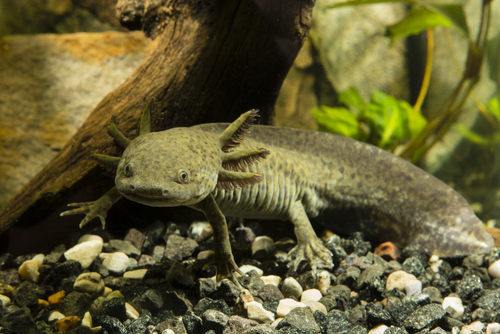
Axolotls (Ambystoma mexicanum) are unique salamanders belonging to the family Ambystomatidae. These fascinating amphibians are characterized by their permanent retention of larval features, a phenomenon known as neoteny.
Unlike other salamanders that undergo metamorphosis, axolotls retain their external gills and juvenile traits throughout their lives.
Native to Lake Xochimilco in Mexico City, axolotls are considered a critically endangered species. Their distinctive appearance includes a large head, broad flat body, and feathery gills that gently wave in the water.
Typically, they can grow up to 9 inches in length, with some reaching as much as 18 inches. Their skin is dark-colored with greenish mottling, and some may even exhibit silvery highlights.
Axolotls are carnivorous and primarily feed on small aquatic animals, such as insects, worms, and mollusks. In captivity, they can be provided with a diet of brine shrimp, bloodworms, and other foods specifically designed for amphibians.
Breeding among axolotls occurs in late winter and early spring, with the male leading a dance-like ritual to entice the female. Axolotls reproduce through indirect fertilization – the male deposits packets of sperm called spermatophores, and the female takes them into her cloaca.
Female axolotls then lay slime-covered eggs on plants or rocks, which hatch into baby axolotls after 15-21 days.
Fun Facts About Axolotl
Most beginner aquarists eventually stumble on the question of “what are baby axolotls called”? Well, the answer is Larvae! They exhibit characteristics commonly found in salamander larvae. For example, there is the external gills and a caudal fin that extends from behind the head to the vent.
It’s not just axolotls, there are other species where the young are called larvae. Any critter undergoing a distinct life stage to reach adulthood is labeled as larval. Frogs are pretty good examples too.
Let’s delve into a few other fascinating baby axolotl facts as we explore their incredible traits below;
- Because of their similarities to salamanders, they are sometimes known by the same collective nouns as a ‘congress‘ or a ‘band‘ of axolotl.
- Baby axolotls exhibit an astounding ability to fully regenerate a limb, encompassing bones, muscles, nerves, and skin, in as little as two weeks. For more extensive repairs, the regeneration process may take between 30 to 60 days.
- In the wild, female axolotls can lay an impressive quantity of eggs. Facilitated by their unrestricted environment, the number ranges from 1000 to 1100 eggs. After laying one clutch, they swiftly become ready to reproduce again.
- The axolotl’s resistance to cancer is remarkable, surpassing that of any other mammal by a large margin. Scientists are optimistic that studying axolotl babies could pave the way for advancements in cancer elimination.
Baby Axolotl Growth and Development
Baby axolotls, also known as larvae, go through a unique growth process. Unlike other salamanders, axolotls experience a phenomenon called neoteny, in which they never outgrow their larval stage and retain their juvenile characteristics throughout their lives.
When axolotl eggs hatch, the larvae measure around 10-13 mm (roughly 0.5 inch) in length. During this initial stage, they still have some egg yolk to sustain them for about 24-72 hours and remain motionless.
After this period, baby axolotls become active and ready to eat. Feeding the hatchlings properly is crucial for their health and growth.
Axolotls are carnivorous, so it’s essential to provide the appropriate food for their nutritional needs. As juveniles, they should be fed small live foods, such as daphnia, brine shrimp, or micro worms.
As they grow, their diet can be transitioned to larger prey items like bloodworms, earthworms, and even small pieces of meat.
The optimum water temperature for axolotls is between 68-72°F (20-22°C). A stable temperature can be maintained using an aquarium heater if necessary. Always use dechlorinated tap water, as chlorine can cause skin irritation in axolotls.
As axolotls grow and develop, it’s essential to monitor their progress regularly. A fully-grown adult axolotl can reach a length of 6 to 18 inches (average size is 9 inches) and weigh up to 10.5 oz (300 grams)
Their growth rate varies, so frequent observations and adjustments to their environment, including tank size and water conditions, are necessary for optimal care.
Axolotl Physical Appearance
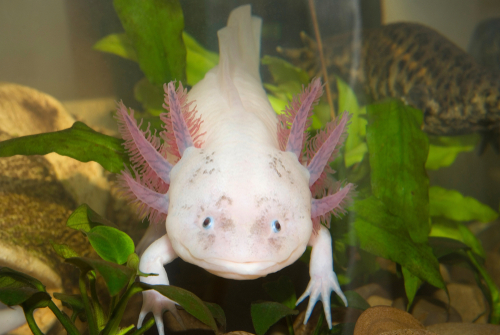
Perhaps to underline the fact that axolotls are not your average amphibian, they sport a range of colors from dark, earthy tones to a greenish hue, often speckled with silvery highlights.
These colors aren’t just for show – they provide an effective camouflage in the axolotl’s natural habitat, helping them blend seamlessly with their surroundings.
Size-wise, they are quite impressive. They can stretch up to a whopping 18 inches in length, although most commonly, they cozy up to a more modest size of around 9 inches.
Their bodies are designed for their aquatic lifestyle, being flat and broad, perfect for navigating the underwater world they call home. But perhaps the most striking feature of an axolotl is its head. It’s large in comparison to its body and houses a pair of small yet prominent eyes.
These eyes, though small, are the windows to the axolotl’s curious and fascinating world. They’re a testament to the their adaptability and resilience, always on the lookout for food, potential threats, and maybe even a bit of fun!
The most distinctive aspect of an axolotl’s appearance is undoubtedly its feathery gills. These external gill stalks originate behind their heads and play a crucial role in respiration, allowing the axolotl to move oxygenated water efficiently.
The gills’ feathery appearance is due to numerous filamentous extensions called filaments, which increase the surface area for gaseous exchange.
Additionally, axolotls possess four limbs that end in tiny, webbed feet. The webbing between the digits assists the axolotl in navigating through the water, providing propulsion and maneuverability.
While the legs are relatively small in proportion to their body size, they are powerful enough to support the their movement, both in water and on land.
In summary, the axolotl’s physical appearance is characterized by its unique coloration, large head with small eyes, feathery gills, and webbed feet. These features make it an easily recognizable and fascinating creature within the world of amphibians.
Natural Habitat and Distribution
The axolotl is an amphibian native to Mexico, primarily found within the lake complex of Xochimilco, near Mexico City. This unique ecosystem comprises a network of canals, floating gardens, and lake remnants, creating a suitable environment for these aquatic creatures to thrive.
The axolotl’s natural habitat consists of freshwater and slow-moving water bodies, offering ample hiding spots and vegetation for the species to enjoy.
Historically, axolotls were also found in Lake Chalco. However, due to urbanization and draining of the lake, the axolotl population in Lake Chalco has been eradicated.
Currently, the wild axolotl’s distribution is limited to the Xochimilco area, which is facing its challenges, such as pollution, invasive species, and habitat loss.
Due to these factors, the International Union for Conservation of Nature and Natural Resources (IUCN) has classified the axolotl as a critically endangered species, with an estimated population of around 50 to 1,000 adult individuals in the wild.
Despite conservation efforts in Mexico, the axolotl’s survival in its natural habitat remains unsecured. In recent years, more attention has been dedicated to breeding axolotls in captivity, both for conservation purposes and as pets.
This approach provides a controlled environment, allowing the delicate creatures to be shielded from the threats present in their dwindling natural habitat.
Baby Axolotl Care

Caring for a baby axolotl is pretty straightforward compared to other salamanders. Think of it like looking after a chill salamander. You have to set up a filtration system and keep the water clean, similar to caring for a fish.
However, these little axolotls are quite sensitive to water conditions, humidity, and how much oxygen is in their tank. So, make sure you meet their tank requirements and keep an eye on that water quality.
So how long do baby axolotls stay with their mother? A recently hatched axolotl typically remains inactive and doesn’t consume food for 24-72 hours.
During this time, they absorb the protein-rich egg yolk. Therefore, baby axolotls do not stay with or depend on their mothers. They are independent from birth. Finding food and avoiding predators all on their own.
Diet and Feeding
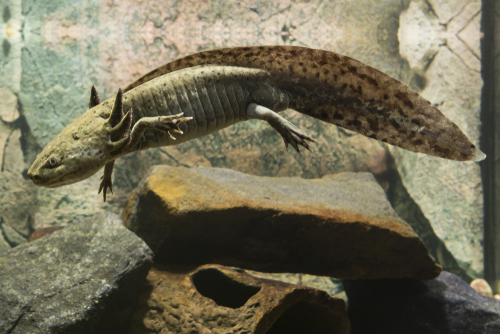
Baby axolotls require a balanced diet consisting mainly of live food such as worms, insects, and small crustaceans. As they grow, the range of food options they can consume will expand, but it’s crucial to provide them with an appropriate diet during their early life stages to ensure proper development and overall health.
In their natural habitat, axolotls are carnivorous predators that consume various meaty foods, like small fish, insects, and worms. Baby axolotls, as well as juvenile ones, can be fed live daphnia (small crustacean), which are widely available in aquarium shops.
These are an excellent source of nutrition and can be offered alongside other live foods such as freshly hatched baby brine shrimp, micro worms, and chopped black worms.
As baby axolotls mature, their diet can be supplemented with freeze-dried or frozen foods, such as bloodworms and brine shrimp. These frozen and dried options offer convenience but should not replace live food entirely. A well-balanced diet is crucial to an axolotl’s growth and overall health.
Feeding baby axolotls can be done by providing 1-2 worms or insects for every 2 inches of their body length. It is essential to monitor the amount of food you provide to ensure that the baby axolotl does not overeat, as overfeeding can lead to health issues.
It is crucial to remove any uneaten food from the tank to maintain a clean environment and prevent the growth of harmful bacteria. This practice also helps in observing your baby axolotl’s appetite and adjusting the feeding schedule accordingly.
Housing and Tank Requirements
When it comes to baby axolotls, one of the most important aspects of their care is their housing and tank setup. To ensure the health and happiness of these adorable creatures, having the right aquarium is essential.
Selecting an appropriate tank size is crucial for your baby axolotl’s wellbeing. As a general rule, a 20-gallon tank should be sufficient for an individual axolotl, as it provides enough space for them to move around comfortably.
The substrate in the axolotl’s habitat plays a vital role in keeping them safe and healthy. Sand is often recommended since it prevents impaction, common when axolotls accidentally ingest the substrate. Avoid using gravel, as it poses a significant risk of swallowing.
Water quality cannot be stressed enough, as axolotls are sensitive to changes in their environment. High-quality water should be maintained by performing regular water changes, removing waste, and monitoring ammonia, nitrite, and nitrate levels.
A high-quality filter will greatly contribute to maintaining a clean environment while producing minimal current, as axolotls prefer calm water.
Water temperature is another key factor in their care. Ideally, the temperature should be between 60-64°F (16-18°C). Temperatures higher than 75°F (24°C) can be harmful and cause stress. Using a thermometer helps to monitor the water temperature, ensuring your axolotl remains comfortable.
In addition to water quality and temperature, the tank should also have a lid. A sturdy lid helps maintain appropriate humidity levels and prevents baby axolotls from climbing out of the tank. It also provides a barrier against potential disturbances or predators.
Minimal lighting is preferred since axolotls do not have eyelids and are native to dark environments. Keeping the tank in a location with low light exposure or using a low-output light source will result in a more comfortable environment for your pet.
By following these guidelines, you can create an ideal home for your baby axolotl, ensuring their good health and happiness. Remember that careful attention to the aquarium, substrate, water quality, water changes, water temperature, lids, and minimal lighting will contribute significantly to your axolotl’s well-being.
Water Requirement
To ensure they live their best lives, specific water conditions are crucial for your baby axolotl tank setup. Maintain the following parameters:
- Temperature: 60-64°F (16-18°C)
- pH: 6.5-8.0
- Chlorine: 0 ppm
- Ammonia: 0 ppm
- Nitrite: 0 ppm
- Nitrate: 0-10 ppm
- Water Hardness: 7-14 GH
Reproduction and Breeding
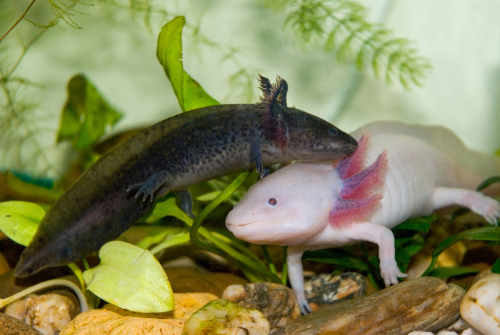
Axolotls, belonging to the Amphibian class, have a unique and intriguing process of reproduction and breeding. The male and female axolotls engage in indirect fertilization, which involves the male depositing spermatophores that the female later picks up to fertilize her eggs.
Sexual maturity is attained by axolotls around the age of 1.5 years old, although in some cases, this can happen as early as 5 months. It is highly recommended that axolotls not be allowed to breed until they are at least 18 months old. This ensures their health and optimal breeding conditions.
During the breeding season, which typically falls between December and June, female axolotls start producing eggs and secrete pheromones into the water.
These pheromones signal to the male that it is time to begin the breeding process. Consequently, the male’s gills become bright red as it starts producing spermatophores.
After a brief courtship, the male releases the spermatophores, which the female will collect to fertilize her eggs. Once the eggs are fertilized, they are laid and attached to surfaces in the tank, such as plants or rocks.
The eggs usually hatch within 2-4 weeks, depending on the water temperature. Upon hatching, the young axolotls, called larvae, are about the size of a grain of rice and possess gills, a tail, and small limb buds.
By understanding axolotl reproduction and breeding, one can better appreciate these fascinating creatures and ensure the successful growth and development of baby axolotls.
Conservation and Threats
The axolotl, a unique amphibian native to Mexico, is currently classified as critically endangered due to various factors affecting its natural habitat and survival. Axolotls are primarily found in Lake Xochimilco, where they face multiple challenges such as pollution and habitat destruction.
One of the major threats to axolotls is environmental pollution. This occurs in the form of chemical pollutants from industries, agricultural runoff, and untreated sewage, leading to toxic water conditions in their habitat. These pollutants cause severe health problems and high mortality rates among axolotl populations.
Another critical factor threatening axolotls is the presence of invasive fish species like tilapia and carp. These invasive fish not only compete with axolotls for resources like food and space, but they also prey on their eggs and larvae. This has led to a significant decline in the axolotl population.
In response to these threats, numerous conservation efforts have been started to protect and restore the axolotl’s natural environment. These efforts include habitat restoration projects, breeding programs, awareness campaigns, and the implementation of stricter fishing regulations to control invasive fish species.
However, challenges still remain in the battle to save this fascinating creature. Consistent monitoring and enforcement are necessary to ensure the effectiveness of conservation measures. Additionally, collaboration between government agencies, non-governmental organizations, and local communities is crucial for safeguarding the future of this species.
Unique Axolotl Abilities

Axolotls are intriguing creatures with a myriad of fascinating features and capabilities. One of their most remarkable abilities is their capacity to regenerate their body parts.
They can regenerate their limbs, tail, heart, and even parts of their brains, which is a rare trait in the animal kingdom. The regeneration process is facilitated by the presence of specialized stem cells, which allows axolotls to heal without forming scars.
These neotenic creatures possess unique physical characteristics that remain consistent throughout their lives. They retain larval features such as feathery external gills and a dorsal fin, even upon reaching sexual maturity. This phenomenon is known as neoteny, and it contributes to their distinctive appearance.
Maintaining a healthy environment for axolotls is essential, as they thrive in cooler water with temperatures between 60-68°F (15-20°C) and prefer natural settings with live plants. Proper tank setup is crucial for their well-being, as stated by Animals Research.
Axolotls are sensitive to changes in temperature and water quality, and even small fluctuations can impact their health significantly.
With their unique physical characteristics and extraordinary regenerative abilities, axolotls continue to capture the interest of researchers and animal enthusiasts alike. Their resilience and adaptability make them a fascinating species for further study and scientific exploration.
Caring for Your Pet Axolotl
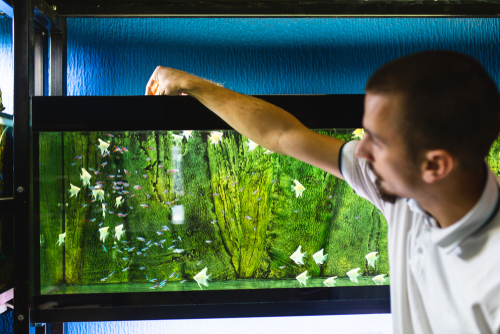
Caring for a pet axolotl requires attention to their habitat, feeding, and overall well-being. Axolotls thrive in clean, cool water environments, so it is essential to maintain a proper tank setup.
A 20-gallon tank with a filtration system is ideal for keeping the water pristine and ensuring your axolotl has enough space to move about. Decorate the tank with natural looking items, such as plants and rocks, to mimic their natural environment and provide hiding spots.
When it comes to the feeding requirements of baby axolotls, they start consuming food after 48 to 72 hours of hatching, beginning with their egg yolks.
Once they are ready to take on solid food, live food like daphnia and baby brine shrimp are excellent options to ensure proper nutrition. These foods are easily digestible, preventing any issues related to their delicate digestive system.
As axolotls grow into adults, their diet may expand to include larger live food options, such as mollusks, earthworms, and bloodworms. Providing a varied diet will help keep your axolotl healthy and satisfied.
Adult axolotls should be fed at least two to three times per week, adjusting the amount according to their appetite. Keep in mind that overfeeding may lead to obesity or impaired mobility, so finding the right balance is crucial.
In addition to feeding, maintaining the water temperature is critical in caring for a pet axolotl. Water temperatures should remain between 60 and 68 degrees Fahrenheit (16-20 degrees Celsius) to provide a comfortable environment for your axolotl. Dramatic fluctuations in temperature can cause stress and potentially lead to health issues.
By following these guidelines and observing your axolotl’s behavior, you can ensure that your pet thrives in a secure and nurturing environment. Constant attention to its habitat and dietary needs will contribute to a long and healthy life for your beloved axolotl.
Common Health Issues
Although axolotls are robust creatures, they are susceptible to various diseases. Some health problems that could affect your baby axolotls are;
1. Exophthalmia
Protruding eyes, or Exophthalmia, can trouble baby axolotls. It often signals they’ve been swimming in high nitrate levels or dealing with not-so-great water conditions. Keep their eyes in check by changing the tank water often, and consider getting a filter to keep the water quality just right.
2. Overfeeding
Axolotls have self-control, but they can overeat, especially the little ones. Overfeeding might lead to obesity and serious health problems, and in extreme cases, it could be fatal. Because young axolotls may struggle with digestion, it’s smart to offer them a small amount of food they can finish in 1-3 minutes. This way, you’re giving them the right nutrition without overdoing it.
3. Underfeeding
While underfeeding is typically less detrimental than overfeeding among axolotls, it can lead to malformed development and delayed maturation in baby axolotls. In severe cases, underfeeding may expose young axolotls to various disorders. Addressing nutrient deficiencies can be achieved by providing nutritious food to your axolotl diet regularly.
4. Skin Infection
Chronic skin ailments such as pustules and abscesses can adversely affect the well-being of young axolotls. These skin infections in young axolotls are often a result of subpar water conditions and pathogens in their tanks. Keeping your baby axolotl in an aquarium with pristine water is a preventive measure against skin diseases.
Additional Considerations
When raising baby axolotls, it is essential to understand their unique biology and ecological requirements. Axolotls are known as neotenic amphibians, meaning they retain their larval features even upon reaching maturity. This creates specific care requirements that set them apart from other aquatic creatures.
In their natural habitat, axolotls inhabit lakes around Mexico City, such as Lake Xochimilco. These areas are characterized by chinampas, a traditional agricultural practice using artificial islands in shallow lakes. Understanding this ecology helps optimize the conditions for baby axolotls in captivity.
Baby axolotls are sensitive to water conditions, humidity, and oxygen supply. Ensuring their tank requirements are met properly and monitoring the water quality is essential to maintaining their health and energy.
Bear in mind that they require a stable temperature between 68-72°F (20-22°C), which can be achieved using an aquarium heater if necessary.
Another crucial factor to consider is cannibalism among baby axolotls. Due to their inherent cannibalistic tendencies, it is vital to separate the babies from their parents and each other when they reach a certain size or show aggressive behavior. This will help prevent harm and reduce stress among the young axolotls.
Feeding baby axolotls properly is crucial to ensure healthy growth. However, avoid overfeeding, as it can have adverse effects on their development. Familiarize yourself with the appropriate feeding techniques and dietary requirements to maintain their wellbeing.
In summary, when caring for baby axolotls, it is crucial to consider their unique biology, ecological requirements, the potential for cannibalism, and appropriate care techniques to ensure they thrive in captivity.
Frequently Asked Questions
How long do baby axolotls stay with their mother?
Baby axolotls do not stay with their mother after hatching. In their larval stage, they absorb their egg yolks, and then, after about 48-72 hours, they’re ready to take on live food.
Axolotl mothers do not provide care for their offspring, so it is essential to create a suitable environment and provide proper nutrition for baby axolotls.
What is the best way to feed bloodworms to baby axolotls?
Feeding bloodworms to baby axolotls is best done with tweezers or pipettes. This method allows you to control the amount of food and ensures that uneaten food does not pollute the water.
Be sure to offer live or freshly thawed frozen bloodworms, as they are more nutritious and appealing to the baby axolotls.
How often should baby axolotls be fed?
Baby axolotls should be fed once or twice a day, depending on their size and age. Smaller or younger axolotls may require more frequent feeding, while larger or older ones may need less frequent feeding. Monitor their growth and adjust the feeding schedule as needed.
What are the optimal water conditions for baby axolotls?
Optimal water conditions for baby axolotls include temperatures between 15-20°C (59-68°F), a pH level between 7.0-7.5, and low levels of ammonia, nitrite, and nitrate. It is essential to maintain clean water by doing regular partial water changes and monitoring the water parameters using a test kit.
How fast do baby axolotls grow?
The growth rate of baby axolotls depends on various factors, including diet, water conditions, and genetics. With proper care, baby axolotls can grow at a steady rate, reaching adult size (20-30 cm or 8-12 inches) within 12-18 months.
Monitor their growth and ensure they are provided with a healthy environment and suitable nutrition.
At what age do baby axolotls become independent?
Axolotls, in general, are solitary from birth and can be considered independent as soon as they start eating live food (around 48-72 hours after hatching).
However, they still require significant care and attention until they reach adulthood. Be sure to provide proper housing, nutrition, and water conditions throughout their life.

Ian Sterling, founder of Fishlab.com, began his aquarium journey over 30 years ago, driven by a deep fascination for fish and their diverse personalities. His website, Fishlab.com, is dedicated to making fishkeeping accessible and enjoyable, offering beginner-friendly guidance, expert insights, and a community for aquarists to connect and share experiences.


